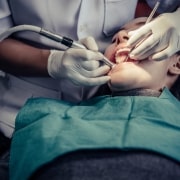What’s the Difference Between Plaque and Tartar?
Plaque and tartar are the bane of existence for people and dentists. Often, people mistakenly interchange these terms, not realizing that there’s a big difference between them. But knowing the difference can make a big…difference…in how well you can keep your teeth free from both. Here’s what you should know about plaque and tartar, from your dentist in Owensboro, KY.
What Is Plaque?
You know that feeling when you wake up all refreshed, ready to start your day, and then—ick—you feel this yucky substance on your teeth? You can’t wait to rush to the bathroom to brush—even before your morning coffee—and until you do, your teeth feel, well, grungy. That’s plaque. Plaque is the soft, sticky film made up of bacteria, food particles and saliva. Plaque has a yellowish tint, and leaving it on your teeth can make teeth look dingy. It’s the kind of tint that makes you want to get your teeth whitened. Plaque forms on the surface of the teeth throughout the day—and overnight—but especially after eating or drinking sugary or starchy foods. Left to its own devices, plaque can lead to cavities, gum irritation and bad breath. The bacteria in the plaque feed on sugars, producing acids that weaken tooth enamel and inflame the gums and potentially causing gingivitis.
What Is Tartar?
Tartar is actually the term for hardened plaque. So even though it’s technically the same thing, it’s very different. And that difference means that it must be dealt with in a completely different manner than plaque. You see, while you can get rid of plaque at home with brushing, you’ll never be able to brush away tartar. For tartar removal, you need to visit your dentist for a dental cleaning in Owensboro, KY.
Two things are needed to keep both tartar and plaque at bay. One, you need to brush and floss on a routine basis. Second, you need to visit your dentist at least every six months. Contact us with any questions or to book an appointment today!



